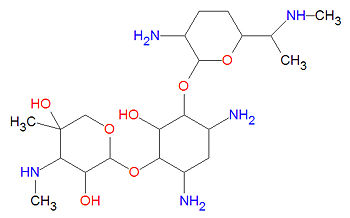Gentamicin: Difference between revisions
imported>David E. Volk (brand names) |
mNo edit summary |
||
| (7 intermediate revisions by 5 users not shown) | |||
| Line 1: | Line 1: | ||
{{subpages}} | {{subpages}} | ||
{{Image|Gentamicin structure.jpg|right|350px|Gentamicin.}} | |||
'''Gentamicin''' is a broad spectrum, | '''Gentamicin''' is a broad spectrum, [[aminoglycoside]] [[antibiotic]] obtained from ''[[Micromonospora purpurea]]'' and related species used to treat serious infections of ''[[Pseudomonas aeruginosa]]'', ''[[Proteus species]]'', ''[[Escherichia coli]]'', ''[[Klebsiella-Enterobactor-Serratia]]'' and ''[[Staphylococcus]]''. It inhibits bacterial growth by binding to the [[30S ribosomal subunit]], causing incorrect reading of [[transfer-RNA|t-RNA]] and stopping protein synthesis. Aminoglycosides, such as gentamicin, are mostly used against gram-negative aerobic bacteria ([[acinetobacter]], [[enterobacter]] and [[pseudomonas]]), but they can be used against some [[mycobacteria]], including [[tuberculosis]]-causing bacteria. Gram-positive bacteria can be treated with aminoglycosides, but better treatment options exist. Anaerobic bacteria, fungi and viruses cannot be treated with gentamicin or other aminoglycosides. In treating streptococcal infections, the combination therapy of gentamicin with penicillin-based antibiotics have been used in treating [[Bacterial endocarditis|endocarditis]]. | ||
==Dosage== | ==Dosage== | ||
| Line 39: | Line 39: | ||
== External links == | == External links == | ||
{{CZMed}} | |||
==References== | ==References== | ||
<references/> | <references/>[[Category:Suggestion Bot Tag]] | ||
Latest revision as of 06:00, 21 August 2024
Gentamicin is a broad spectrum, aminoglycoside antibiotic obtained from Micromonospora purpurea and related species used to treat serious infections of Pseudomonas aeruginosa, Proteus species, Escherichia coli, Klebsiella-Enterobactor-Serratia and Staphylococcus. It inhibits bacterial growth by binding to the 30S ribosomal subunit, causing incorrect reading of t-RNA and stopping protein synthesis. Aminoglycosides, such as gentamicin, are mostly used against gram-negative aerobic bacteria (acinetobacter, enterobacter and pseudomonas), but they can be used against some mycobacteria, including tuberculosis-causing bacteria. Gram-positive bacteria can be treated with aminoglycosides, but better treatment options exist. Anaerobic bacteria, fungi and viruses cannot be treated with gentamicin or other aminoglycosides. In treating streptococcal infections, the combination therapy of gentamicin with penicillin-based antibiotics have been used in treating endocarditis.
Dosage
The Prins nomogram uses simplified once daily dosing with the dose adjusted for renal function.[1] Depending on the estimated creatinine clearance (CC) (Online calculator), the daily intravenous dose is:
- CC more than 80 ml/min - 4 mg/kg
- CC between 50 and 80 ml/min - 3.25 mg/kg
- CC between 30 and 50 ml/min - 2.5 mg/kg
- CC below 30 ml/min - 2 mg/kg
The older Hull and Sarubbi nomogram uses a loading dose followed by smaller maintenance doses depending on renal function.[2]
Mechanism of action
Aminoglycosides irreversibly bind to specific 30S-subunit proteins and 16S rRNA. Specifically, gentamicin binds to four nucleotides of the 16S rRNA and one amino acid in protein S12. This interferes with decoding near nucleotide 1400 in 16S rRNA of the 30S subunit, interfering with the formation of an initiation complex, causing misreading of mRNA so that incorrect amino acids are inserted into the polypeptide leading to nonfunctional or toxic peptides and the breakup of polysomes into nonfunctional monosomes.
Brand names
- Alcomicin®
- Apogen®
- Bristagen®
- G-Mycin®
- G-Myticin®
- Garamycin®
- Garamycin Otic Solution®
- Genoptic Liquifilm®
- Genoptic S.O.P.®
- Gentacidin®
- Gentafair®
- Gentak®
- Gentamar®
- Gentamcin Sulfate®
- Jenamicin®
- Ocu-Mycin®
- Spectro-Genta®
- U-gencin®
External links
The most up-to-date information about Gentamicin and other drugs can be found at the following sites.
- Gentamicin - FDA approved drug information (drug label) from DailyMed (U.S. National Library of Medicine).
- Gentamicin - Drug information for consumers from MedlinePlus (U.S. National Library of Medicine).
- Gentamicin - Detailed information from DrugBank.
References
- ↑ Prins JM, Weverling GJ, de Blok K, van Ketel RJ, Speelman P (1996). "Validation and nephrotoxicity of a simplified once-daily aminoglycoside dosing schedule and guidelines for monitoring therapy". Antimicrob. Agents Chemother. 40 (11): 2494–9. PMID 8913452. [e] Full text at PubMed Central
- ↑ Hull JH, Sarubbi FA (1976). "Gentamicin serum concentrations: pharmacokinetic predictions". Ann. Intern. Med. 85 (2): 183–9. PMID 942138. [e] online
